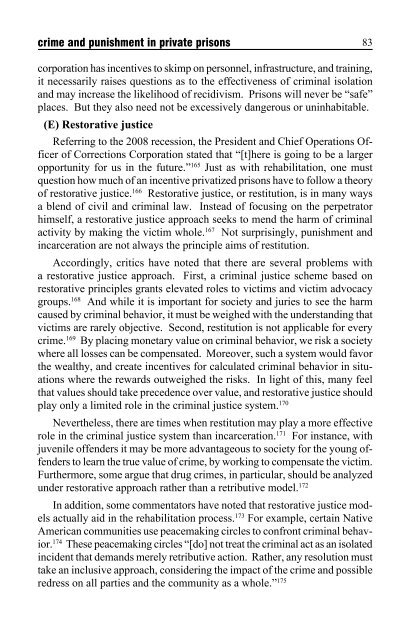Does your library have National Lawyers Guild Review?
Does your library have National Lawyers Guild Review?
Does your library have National Lawyers Guild Review?
You also want an ePaper? Increase the reach of your titles
YUMPU automatically turns print PDFs into web optimized ePapers that Google loves.
crime and punishment in private prisons83corporation has incentives to skimp on personnel, infrastructure, and training,it necessarily raises questions as to the effectiveness of criminal isolationand may increase the likelihood of recidivism. Prisons will never be “safe”places. But they also need not be excessively dangerous or uninhabitable.(E) Restorative justiceReferring to the 2008 recession, the President and Chief Operations Officerof Corrections Corporation stated that “[t]here is going to be a largeropportunity for us in the future.” 165 Just as with rehabilitation, one mustquestion how much of an incentive privatized prisons <strong>have</strong> to follow a theoryof restorative justice. 166 Restorative justice, or restitution, is in many waysa blend of civil and criminal law. Instead of focusing on the perpetratorhimself, a restorative justice approach seeks to mend the harm of criminalactivity by making the victim whole. 167 Not surprisingly, punishment andincarceration are not always the principle aims of restitution.Accordingly, critics <strong>have</strong> noted that there are several problems witha restorative justice approach. First, a criminal justice scheme based onrestorative principles grants elevated roles to victims and victim advocacygroups. 168 And while it is important for society and juries to see the harmcaused by criminal behavior, it must be weighed with the understanding thatvictims are rarely objective. Second, restitution is not applicable for everycrime. 169 By placing monetary value on criminal behavior, we risk a societywhere all losses can be compensated. Moreover, such a system would favorthe wealthy, and create incentives for calculated criminal behavior in situationswhere the rewards outweighed the risks. In light of this, many feelthat values should take precedence over value, and restorative justice shouldplay only a limited role in the criminal justice system. 170Nevertheless, there are times when restitution may play a more effectiverole in the criminal justice system than incarceration. 171 For instance, withjuvenile offenders it may be more advantageous to society for the young offendersto learn the true value of crime, by working to compensate the victim.Furthermore, some argue that drug crimes, in particular, should be analyzedunder restorative approach rather than a retributive model. 172In addition, some commentators <strong>have</strong> noted that restorative justice modelsactually aid in the rehabilitation process. 173 For example, certain NativeAmerican communities use peacemaking circles to confront criminal behavior.174 These peacemaking circles “[do] not treat the criminal act as an isolatedincident that demands merely retributive action. Rather, any resolution musttake an inclusive approach, considering the impact of the crime and possibleredress on all parties and the community as a whole.” 175












![NLGRev 68-2[1].indd - National Lawyers Guild](https://img.yumpu.com/30820772/1/167x260/nlgrev-68-21indd-national-lawyers-guild.jpg?quality=85)



